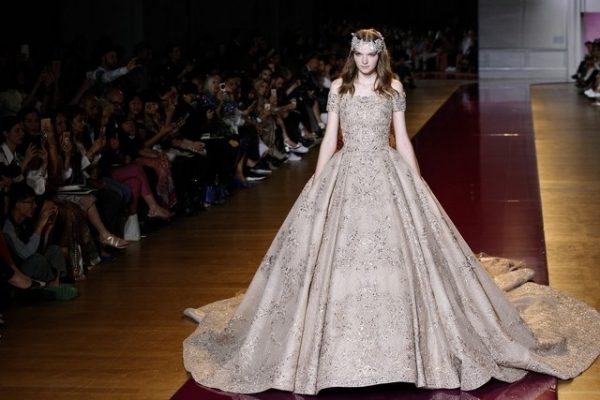
As an acknowledgement of the human toil that goes into the design process, Karl Lagerfeld paid tribute to Chanel’s seamstresses and embroiderers by recreating their ateliers on stage at Paris Haute Couture Week earlier this month. Valentino frequently notes on its programmes the hours spent on embroidered dresses. Four hundred hours is not uncommon, although a remarkable Renaissance-style dress covered in antique patchwork appliqué took 1,200 hours to construct and is a testimony to the skills of the Rome atelier.
The maisons of Chanel and Valentino have been part of the upper echelons of haute couture fashion for many years. However, Beirut-based couturiers could well be proud of the skills displayed by their own ateliers, given the quality and abundance of extraordinary embroidered craft decorating their latest collections in Paris.
Beaded embellishment is a speciality for the likes of Zuhair Murad, Elie Saab, Georges Hobeika and relative newcomer Rami Kadi. Skilled artisans in Beirut and Paris have spent thousands of hours over the last few months lavishing silk and tulle with delicate beading, in readiness for the collections.
Embroidered flowers are a stock in trade for most designers, but Elie Saab chose to scatter flocks of blue and silver swallows on capes and 1940s-style gowns. Feathers both real and embroidered, and golden starbursts covered the evening wear along with art deco embroidery that echoed the New York set and overall theme for his collection.
Zuhair Murad describes his take on couture as much more “bohemian — very rock chick, but couture at the same time”. Accordingly, his was an upscale version of 1970s hippie chic with sweeping velvet capes, jumpsuits and thigh-high boots. Murad’s embroidery ateliers busily worked on tattoo-like embroideries and Chantilly laces mixed with macramé for long-tiered dresses modelled with big felt hats.
Georges Hobeika’s vision is less about attitude and more traditionally feminine, with pretty and colourful floral-appliqué dresses, paired with dainty handbags. Nevertheless, it was good to see him do a few jewelled trainers to give some of that sweet femininity a bit of pithiness.
Rami Kadi worked with innovative materials such as silicon lace for dresses; silver silicon for a feather opera coat; and printed motifs that are heat-transferred to grand evening gowns. “I love technology and couture, and like to use a mixture of traditional and modern to create something young, playful and original,” says the designer, who was presenting his fifth collection in Paris.
Craftsmanship was not solely limited to embellishment. Frenchman Gilles Mendel of New York’s famous J Mendel fur brand was making his haute couture debut with 24k gold gilding his fur jackets, and astonishing shaved mink “sequins” embroidered into large abstract patterns to construct dresses and coats.
This being the autumn collections in Paris, there were beautiful patchwork furs at Jean Paul Gaultier as well, along with an handmade olive passementerie parka and woodgrain-printed dresses. It is this sort of craftsmanship — created by often unheralded artisans behind the scenes — that makes haute couture something to be celebrated in a world now dominated by fast fashion.
THE NATIONAL
Leave a Reply
You must be logged in to post a comment.